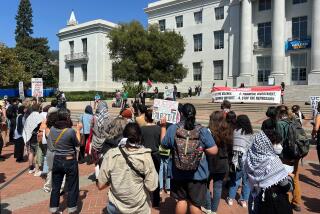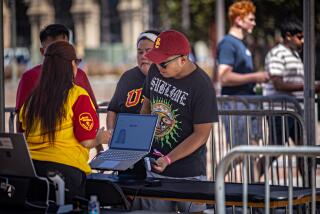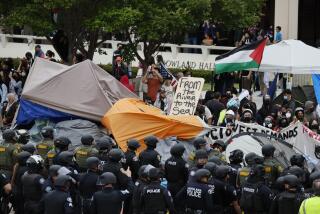‘Antifa’ violence in Berkeley spurs soul-searching within leftist activist community
Reporting from Berkeley — Of the dozens of organizations that turned out for Sunday’s mass protest against racism here, one group was impossible to miss.
Its members dressed head to toe in black, with masked faces and some bearing pastel-painted riot shields that read “no hate.” These 100 or so militants billed themselves as a security force for progressive counter-protesters, vowing to protect them from far-right agitators.
But as the protest got underway, some of those in masks would resort to mob violence, attacking a small showing of supporters of President Trump and others they accused, sometimes inaccurately, of being white supremacists or Nazis.
The graphic videos of those attacks have spurred soul-searching within the leftist activist movement in the Bay Area and beyond. Emotions remain raw in the wake of this month’s white supremacist rally in Charlottesville, Va., which left one woman dead and dozens injured.
Does violence help Trump’s claims?
Trump received blistering criticism for equating the behavior of Klansmen and neo-Nazis to the actions of those who opposed them. Some fear that Sunday’s violence would only help advance the idea that the two sides are the same.
“This is food for the adversary,” said sociologist Todd Gitlin, a founder of Students for a Democratic Society, which organized the first national protests against the Vietnam War. He pointed out that violent acts committed by a few will almost always hijack the narrative of the entire protest, and that it is happening now should be no surprise.
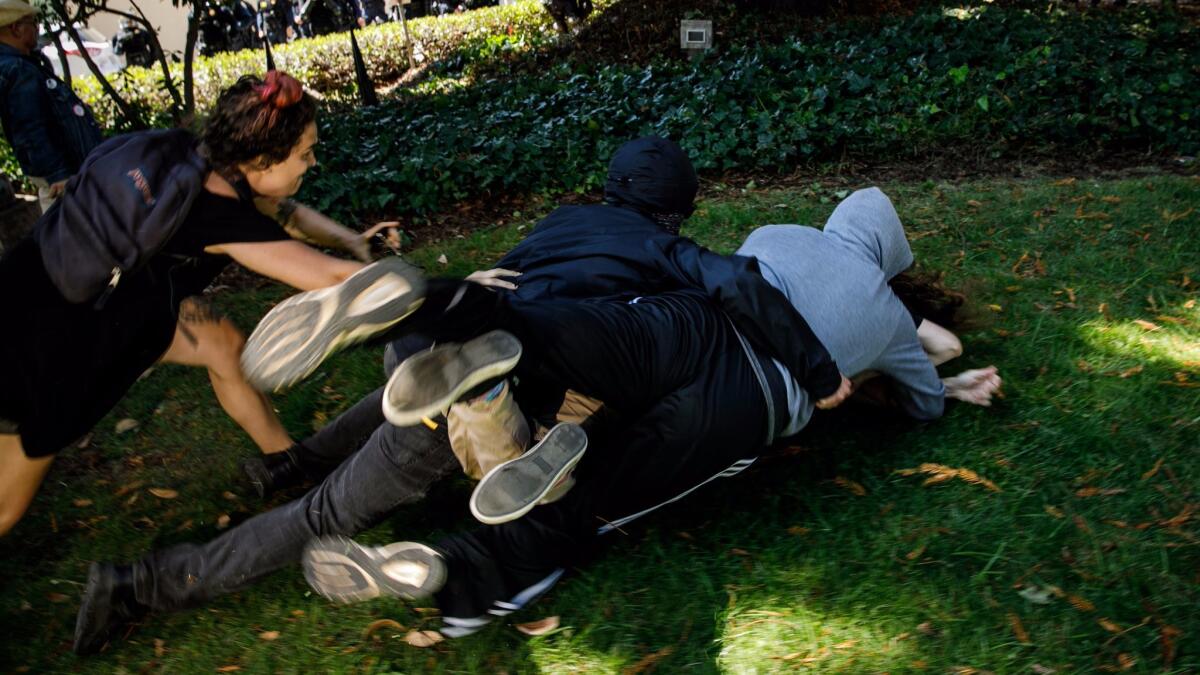
Gitlin also described what he sees as a push by the anti-fascist — also called “antifa” — movement to put “themselves on the map of protest” by using violence to “intimidate” both political opponents and those on the left who promote non-violence. One of the biggest banners at the Berkeley demonstration carried the message “Avenge Charlottesville.”
Militants who showed up Sunday were part of a multifaceted rally in which church leaders sang gospel and anti-fascists shouted profanities. Berkeley police estimated more than 4,000 people came out to take over a city park where far-right activists had called for an anti-Marxism rally. The organizer canceled the event Friday, citing security concerns, but a small number of far-right activists showed up anyway.
By the end of the day, 13 people had been arrested, one on suspicion of assault with a deadly weapon and three on battery charges.
Playing a ‘defensive role’
Jeff Conant, a member of an East Bay collective of anti-racist demonstrators known as Showing Up For Racial Justice, said march organizers asked allies in the antifa movement to “play a defensive role” in the rally — not to engage in or start violence.
Those in the black hoods fell in with the marchers, while the lead truck for the march carried stacks of pastel-painted riot shields that anti-fascist demonstrators later raised against police.
Participants further were told not to record the day on their cellphones, and urged to write a legal aid phone number on their arms in case of arrest.
The march reached a park, which police had already cleared of far-right figures. The demonstrators lined up behind their shields against a police barricade and officers armed with riot guns.
Elsewhere, the hooded group would mob, and in some cases kick and beat, a handful of far-right supporters. Several antifa members were seen using their shields to batter opponents, including one who was slammed into the back of a man running out of Martin Luther King Jr. Civic Center Park. Berkeley police said they were aware of four such incidents during the day.
The images sparked criticism from both conservatives as well as some liberals who had hoped the march would be peaceful after several violent confrontations between left and right extremists in Berkeley earlier this year.
After the crowd began to disperse, Berkeley Police Chief Andrew Greenwood held a tense discussion with a church organizer concerned that peaceful protesters would be lumped in with the militants. Greenwood said his officers had seen antifa and black bloc forces preparing alongside the rest of the demonstrators, at a staging point some four blocks away.
“They were practicing with weapons,” Greenwood said.
Conant said the drills were defensive, justified by violence at other demonstrations in the past year.
Organizers defended the militant force, saying it was necessary because police do not wade into protest brawls themselves. Far-right activists also criticized police for not better protecting them.
Berkeley police said having officers jump into the crowd would have inflamed already an already volatile situation. However, on Sunday, police several times rescued people chased by the crowd or escorted them out.
Why ‘silence’ opposition?
Among those appalled by the increasingly militant force are radicals from the 1960s peace movement.
Political scientist Jo Freeman, part of the radical student movement that forced UC Berkeley to permit political speech five decades ago, said she was dismayed at the effort that went into silencing opposition. She drew similarities between those who threatened her and other freedom marchers in the South in the 1960s, and those who bully the far right now.
“It is not uncommon for societies to produce a hate squad,” Freeman said. “People who want to suppress the right to speak — they are everywhere.”
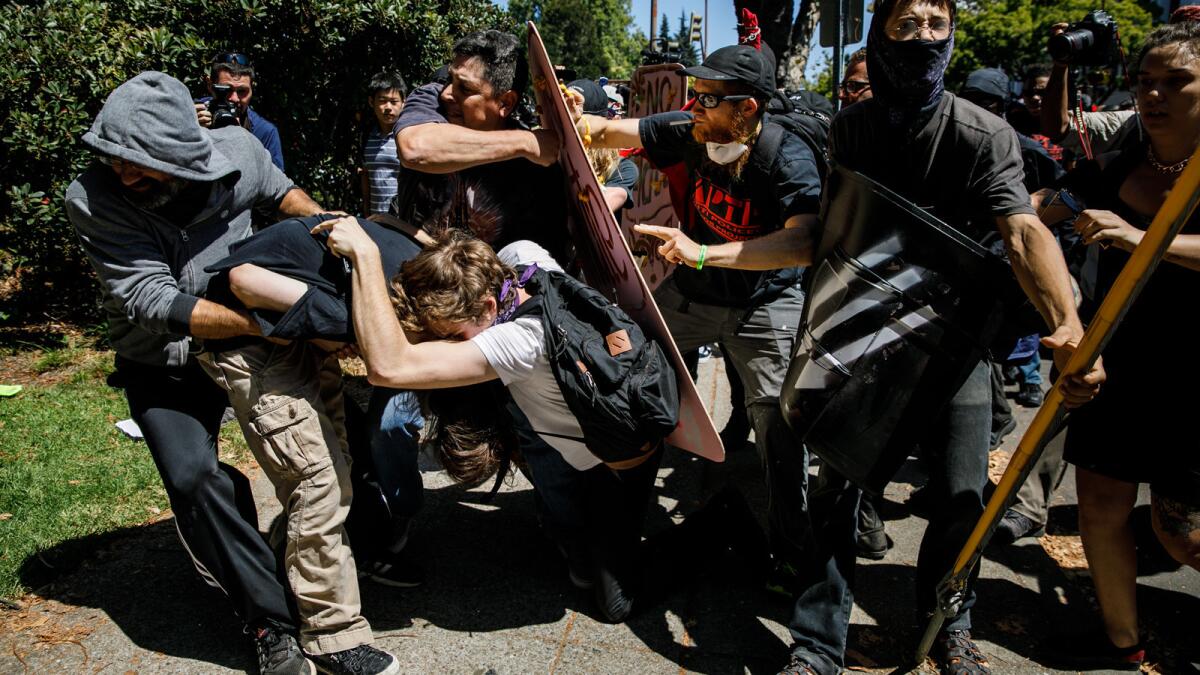
Kitty Stryker, a Berkeley activist affiliated with groups like Struggalo Circus, which offer medical aid during protests, said she was heartbroken to see media coverage of Sunday’s demonstration focus on violence. She said she saw a Trump supporter pepper spray a black bloc member and said it was disingenuous to say anti-fascists alone incited violence.
“I do think there was a lot of anger over Charlottesville, as there should be,” Stryker said. “But I also think there was a sudden realization that many of the instigators in Charlottesville had been coming to Berkeley for months to beat up anti-fascists.”
UC Berkeley braces for more
UC Berkeley is reviewing the weekend demonstrations as it plans how to handle a series of conservative political speakers in late September. Campus spokesman Dan Mogulof said student safety is the first priority – “there is nothing more important.”
“Anyone who was here [in February] had their eyes open to what happens when groups like this are willing to use violent tactics to disrupt events and attack those with whom they disagree,” Mogulof said, referring to black bloc demonstrators who violently joined a campus demonstration to shut down a speech by Milo Yiannopoulos.
“While this may be different in terms of numbers, it doesn’t represent a substantial departure in tactics. It’s deeply concerning, but we have confidence in our police department,” Mogulof said.
Conant said he was more concerned with protecting demonstrators than how right-wing groups might capitalize on images of antifa violence.
“There are moments where optics are important … I don’t think this is that moment,” he said.
Twitter: @paigestjohn
Twitter: @jamesqueallyLAT
ALSO
Violence by far-left protesters in Berkeley sparks alarm
Editorial: Violent demonstrators in Berkeley are thugs, not activists
UC Berkeley chancellor unveils ‘Free Speech Year’ as right-wing speakers plan campus events
More to Read
Sign up for Essential California
The most important California stories and recommendations in your inbox every morning.
You may occasionally receive promotional content from the Los Angeles Times.
